Cite this document
(Health and Illness Across the Lifespan of Diabetes Case Study, n.d.)
Health and Illness Across the Lifespan of Diabetes Case Study. Retrieved from https://studentshare.org/health-sciences-medicine/1641719-health-and-illness-across-the-lifespan-of-diabetes
Health and Illness Across the Lifespan of Diabetes Case Study. Retrieved from https://studentshare.org/health-sciences-medicine/1641719-health-and-illness-across-the-lifespan-of-diabetes
(Health and Illness Across the Lifespan of Diabetes Case Study)
Health and Illness Across the Lifespan of Diabetes Case Study. https://studentshare.org/health-sciences-medicine/1641719-health-and-illness-across-the-lifespan-of-diabetes.
Health and Illness Across the Lifespan of Diabetes Case Study. https://studentshare.org/health-sciences-medicine/1641719-health-and-illness-across-the-lifespan-of-diabetes.
“Health and Illness Across the Lifespan of Diabetes Case Study”. https://studentshare.org/health-sciences-medicine/1641719-health-and-illness-across-the-lifespan-of-diabetes.


